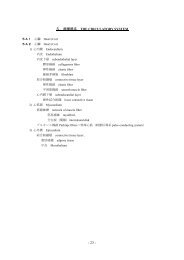Program / Abstract Book - KMU WWW3 Server for Education ...
Program / Abstract Book - KMU WWW3 Server for Education ...
Program / Abstract Book - KMU WWW3 Server for Education ...
Create successful ePaper yourself
Turn your PDF publications into a flip-book with our unique Google optimized e-Paper software.
No. 17 (PC 17)<br />
Development of C-reactive protein assay <strong>for</strong> human saliva<br />
Yumi Narita, Taku Shirakawa<br />
Department of Biophysics, Graduate School of Health Sciences, Kobe University, Japan<br />
BACKGROUND: Measurement of C-reactive protein (CRP) in saliva may be able to be used <strong>for</strong> the<br />
early detection of the inflammatory disorder of infants or home care patients. However, the reports about<br />
the correlation between salivary and serum CRP vary among researchers. Such differences might be<br />
caused in the step of pretreatment or collection of saliva. In this study, we examined these steps in order<br />
to develop a high-sensitivity assay <strong>for</strong> salivary CRP.<br />
METHODS: Salivary CRP concentration was determined by sandwich enzyme-linked immunoassay<br />
(ELISA). To improve the sensitivity of the assay, Ampliflu TM Red (Sigma) was used as a fluorogenic<br />
substrate. Saliva was collected by drooling and/or saliva collection swab. Saliva samples were diluted<br />
1:1 in sample diluent containing Tween20 and/or cation, then centrifuge at 1500g <strong>for</strong> 5 minutes.<br />
Concentrations of Tween20 and cations were examined in 0 to 1% and 0 to 1000mM, respectively. The<br />
validity of ELISA was examined by intra-assay precision and recovery test. Saliva and serum samples<br />
from 28 healthy volunteers were collected, and then CRP concentrations were measured in order to<br />
evaluate the correlation of salivary and serum CRP.<br />
RESULTS: 500mmol/L MgCl2 and 0.25%Tween20 were best at enhancing the CRP fluorescent signal.<br />
Both MgCl2 and Tween20 were essential to detect strong signal. Under these conditions intra-assay CV<br />
was 3.0%, and recovery was 102-107%. CRP concentration decreased 30% in samples collected with<br />
saliva collection swabs in comparison with drooling. CRP was measurable in saliva samples (84.8 to<br />
4104.3pg/mL) and serum samples (26.0 to 2015.4ng/mL). There was a positive correlation between<br />
salivary and serum CRP (r=0.77).<br />
CONCLUSIONS: Strong enhancement of CRP fluorescent signal was observed in the presence of<br />
MgCl2 and Tween20. Salivary CRP concentration was affected by collection method. Salivary CRP and<br />
serum CRP moderately correlated. This result will support <strong>for</strong> the validation of salivary CRP as an<br />
alternative marker of inflammation.<br />
- 70 -



